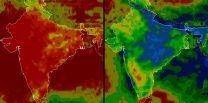Backward-moving glacier helps scientists explain glacial earthquakes
2015-06-25
(Press-News.org) The relentless flow of a glacier may seem unstoppable, but a team of UK and US researchers have shown that during some calving events - when an iceberg breaks off into the ocean - the glacier moves rapidly backward and downward, causing the characteristic glacial earthquakes which until now have been poorly understood.
This new insight into glacier behaviour should enable scientists to measure glacier calving remotely and will improve the reliability of models that predict future sea-level rise in a warming climate.
The research is published today in Science Express.
The Greenland Ice Sheet is an important contributor to global sea-level and nearly half of the ice sheet's annual mass loss occurs through the calving of icebergs to the ocean. Glacial earthquakes have increased seven-fold in the last two decades and have been migrating north suggesting an increase in rates of mass loss from the ice sheet through calving.
Helheim Glacier is one of the largest glaciers in southeast Greenland and at 6 km wide and over 200 km long it can flow as fast as 30 m per day. Icebergs calving from Helheim Glacier can be very large and have been measured up to 4 km across and with a volume of about 1.25 km3.
During the summer of 2013, researchers from Swansea, Newcastle and Sheffield Universities installed a robust wireless network of Global Positioning System (GPS) devices on the chaotic surface of Helheim in order to measure velocity and displacement of the glacier surface. With US collaborators from Columbia University's Lamont-Doherty Earth Observatory, the University of Michigan and Emory University, earthquake data from the Global Seismographic Network and scaled-down models in water tanks were used to explain the unexpected movements of the glacier in the minutes surrounding the calving events.
Swansea University's Professor Tavi Murray, lead author of the study said, "We were really surprised to see the glacier flowing backwards in our GPS data. The motion happens every time a large iceberg is calved and a glacial earthquake is produced. A theoretical model for the earthquakes and the laboratory experiments have allowed us to explain the backwards and downwards movement."
Understanding this glacier behaviour and the associated glacial earthquakes is a crucial step towards measuring calving events and their contribution to sea-level change remotely. This tool has the potential to provide unprecedented, global and near real-time estimates of iceberg loss from the ice sheet.
INFORMATION:
This research was supported by the UK Natural Environment Research Council, the US National Science Foundation and the Climate Change Consortium of Wales and Thales UK.
ELSE PRESS RELEASES FROM THIS DATE:
2015-06-25
Scientists at the University of York and GlaxoSmithKline (GSK) Australia have made a key genetic discovery in poppies, paving the way for more effective painkillers.
The discovery, published in the latest issue of Science, reveals the long sought after gene that is seen as a critical gateway step in the synthesis of the morphinan class of alkaloids, which include the painkiller drugs morphine and codeine.
The gene, called STORR, is only found in poppy species that produce morphinans. The STORR gene evolved when two other genes encoding oxidase and reductase enzymes ...
2015-06-25
Electrical engineers have broken key barriers that limit the distance information can travel in fiber optic cables and still be accurately deciphered by a receiver. Photonics researchers at the University of California, San Diego have increased the maximum power -- and therefore distance -- at which optical signals can be sent through optical fibers. This advance has the potential to increase the data transmission rates for the fiber optic cables that serve as the backbone of the internet, cable, wireless and landline networks. The research is published in the June 26 issue ...
2015-06-25
PITTSBURGH--Scientific controversies, from problems replicating results - such as with the now debunked association between autism and MMR vaccines - to researcher misconduct and sensationalism, have led to speculation of "trouble at the lab," as the Economist put it.
The National Academy of Sciences (NAS) and the Annenberg Retreat at Sunnylands recently convened top scientists from Carnegie Mellon University, the University of California, Massachusetts Institute of Technology, Georgia Institute of Technology and other leading institutions to examine ways to return to ...
2015-06-25
PITTSBURGH, June 18, 2015 - Researchers at the University of Pittsburgh School of Medicine have devised a computational model that could enhance understanding, diagnosis and treatment of pressure ulcers related to spinal cord injury. In a report published online in PLOS Computational Biology, the team also described results of virtual clinical trials that showed that for effective treatment of the lesions, anti-inflammatory measures had to be applied well before the earliest clinical signs of ulcer formation.
Pressure ulcers affect more than 2.5 million Americans annually ...
2015-06-25
Chloroplasts, better known for taking care of photosynthesis in plant cells, play an unexpected role in responding to infections in plants, researchers at UC Davis and the University of Delaware have found.
When plant cells are infected with pathogens, networks of tiny tubes called stromules extend from the chloroplasts and make contact with the cell's nucleus, the team discovered. The tubes likely deliver signals from the chloroplast to the nucleus that induce programmed cell death of infected cells and prepare other cells to resist infection. The work is published online ...
2015-06-25
Magnolias are prized for their large, colorful, fragrant flowers. Does the attractive, showy tree also harbor a potent cancer fighter?
Yes, according to a growing number of studies, including one from VA and the University of Alabama at Birmingham that is now online in the journal Oncotarget.
The study focused on squamous cell head and neck cancers, a scourge among those who use tobacco and alcohol. According to the National Cancer Institute, at least 3 in 4 head and neck cancers are caused by the use of tobacco and alcohol. The cancers have only a 50 percent survival ...
2015-06-25
Without new conservation efforts, the Democratic Republic of Congo (DRC) could lose up to 20 percent of its forests, unleashing a 60 percent increase in carbon emissions, says a new study by researchers at the University of Vermont's Gund Institute for Ecological Economics.
Published by PLOS ONE, the study explores Central Africa's tropical forests, which are among the world's largest carbon reserves. While these forests have historically experienced low deforestation rates, pressures to clear land are growing due to development, foreign investment in agriculture, and ...
2015-06-25
An international group of academic leaders, journal editors and funding-agency representatives and disciplinary leaders, including Rick Wilson, the Herbert S. Autrey Chair of Political Science and professor of statistics and psychology at Rice University, has announced guidelines to further strengthen transparency and reproducibility practices in science research reporting.
The group, the Transparency and Openness Promotion (TOP) Committee at the Center for Open Science in Charlottesville, Va., outlined its new guidelines in a story published in this week's edition of ...
2015-06-25
Rainwater could save people in India a bucket of money, according to a new study by scientists looking at NASA satellite data.
The study, partially funded by NASA's Precipitation Measurement Missions, found that collecting rainwater for vegetable irrigation could reduce water bills, increase caloric intake and even provide a second source of income for people in India.
The study, published in the June issue of Urban Water Journal, is based on precipitation data from the Tropical Rainfall Measuring Mission (TRMM), a joint mission between NASA and the Japan Aerospace ...
2015-06-25
The majority of the United States' poor aren't sitting on street corners. They're employed at low-paying jobs, struggling to support themselves and a family.
In the past, differing definitions of employment and poverty prevented researchers from agreeing on who and how many constitute the "working poor."
But a new study by sociologists at BYU, Cornell and LSU provides a rigorous new estimate. Their work suggests about 10 percent of working households are poor. Additionally, households led by women, minorities or individuals with low education are more likely to be ...
LAST 30 PRESS RELEASES:
[Press-News.org] Backward-moving glacier helps scientists explain glacial earthquakes


